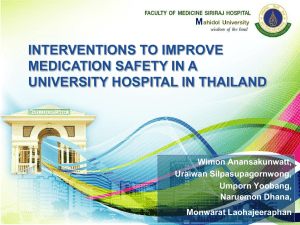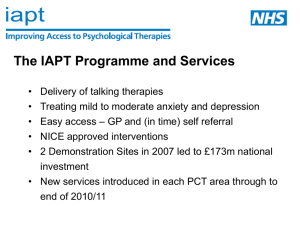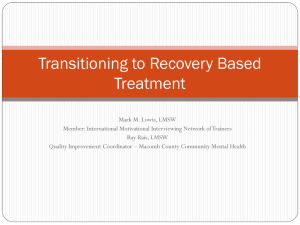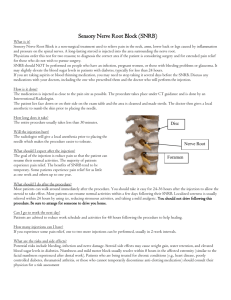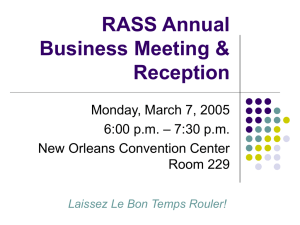Pain Management - Adult - Medication Safety Officers Society
advertisement
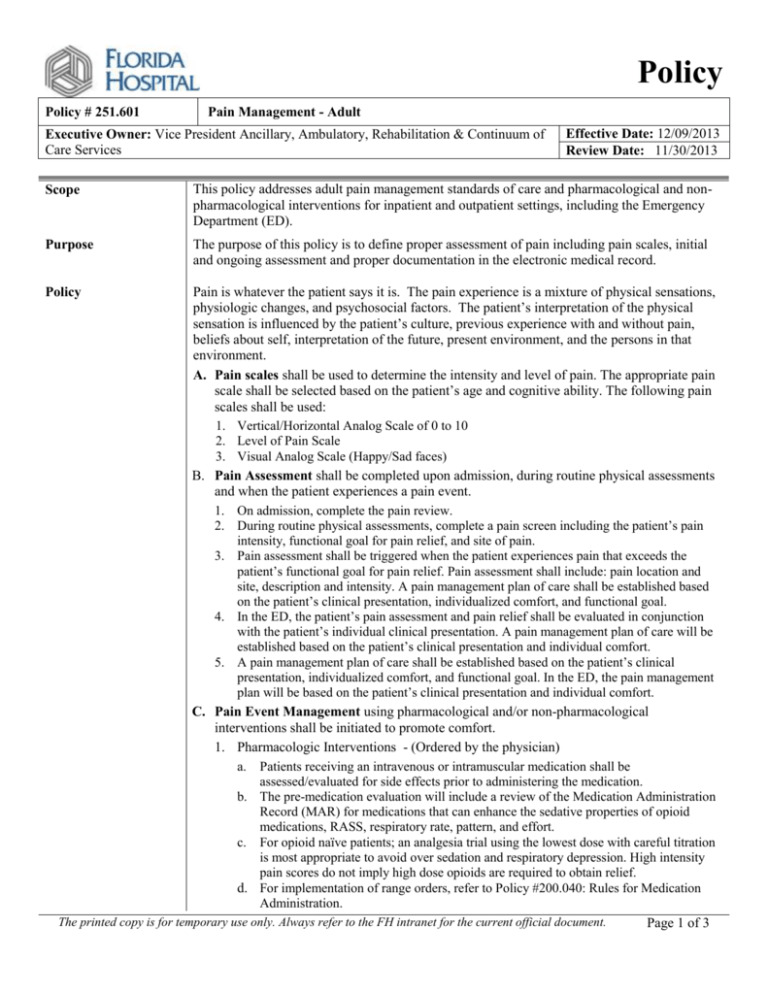
Policy Policy # 251.601 Pain Management - Adult Executive Owner: Vice President Ancillary, Ambulatory, Rehabilitation & Continuum of Care Services Effective Date: 12/09/2013 Review Date: 11/30/2013 Scope This policy addresses adult pain management standards of care and pharmacological and nonpharmacological interventions for inpatient and outpatient settings, including the Emergency Department (ED). Purpose The purpose of this policy is to define proper assessment of pain including pain scales, initial and ongoing assessment and proper documentation in the electronic medical record. Pain is whatever the patient says it is. The pain experience is a mixture of physical sensations, physiologic changes, and psychosocial factors. The patient’s interpretation of the physical sensation is influenced by the patient’s culture, previous experience with and without pain, beliefs about self, interpretation of the future, present environment, and the persons in that environment. A. Pain scales shall be used to determine the intensity and level of pain. The appropriate pain scale shall be selected based on the patient’s age and cognitive ability. The following pain scales shall be used: 1. Vertical/Horizontal Analog Scale of 0 to 10 2. Level of Pain Scale 3. Visual Analog Scale (Happy/Sad faces) B. Pain Assessment shall be completed upon admission, during routine physical assessments and when the patient experiences a pain event. 1. On admission, complete the pain review. 2. During routine physical assessments, complete a pain screen including the patient’s pain intensity, functional goal for pain relief, and site of pain. 3. Pain assessment shall be triggered when the patient experiences pain that exceeds the patient’s functional goal for pain relief. Pain assessment shall include: pain location and site, description and intensity. A pain management plan of care shall be established based on the patient’s clinical presentation, individualized comfort, and functional goal. 4. In the ED, the patient’s pain assessment and pain relief shall be evaluated in conjunction with the patient’s individual clinical presentation. A pain management plan of care will be established based on the patient’s clinical presentation and individual comfort. 5. A pain management plan of care shall be established based on the patient’s clinical presentation, individualized comfort, and functional goal. In the ED, the pain management plan will be based on the patient’s clinical presentation and individual comfort. C. Pain Event Management using pharmacological and/or non-pharmacological interventions shall be initiated to promote comfort. 1. Pharmacologic Interventions - (Ordered by the physician) a. Patients receiving an intravenous or intramuscular medication shall be assessed/evaluated for side effects prior to administering the medication. b. The pre-medication evaluation will include a review of the Medication Administration Record (MAR) for medications that can enhance the sedative properties of opioid medications, RASS, respiratory rate, pattern, and effort. c. For opioid naïve patients; an analgesia trial using the lowest dose with careful titration is most appropriate to avoid over sedation and respiratory depression. High intensity pain scores do not imply high dose opioids are required to obtain relief. d. For implementation of range orders, refer to Policy #200.040: Rules for Medication Administration. The printed copy is for temporary use only. Always refer to the FH intranet for the current official document. Page 1 of 3 Policy Policy Policy # 251.601 Pain Management - Adult Executive Owner: Vice President Ancillary, Ambulatory, Rehabilitation & Continuum of Care Services D. E. F. G. Definitions Effective Date: 12/09/2013 Review Date: 11/30/2013 2. Non-pharmacologic interventions. 3. For persistent pain, the following interventions may be considered: a. Seek recommendations from pharmacist, campus pain coordinator, unit pain resource nurse, or palliative care team. b. Request physician to consider either Acute or Chronic Pain Management Specialty, or Pharmacy Consult. 4. Orders to administer placebos for oral, parenteral, or any other route for administration of pain medications are not acceptable and shall not be implemented or used. The ordering physician shall be contacted to change the order to a non-placebo analgesic. Pain Medication Side Effects and Pain Relief Reassessment 1. Medication side effects shall be completed within 15 minutes of intravenous (IV) administration; within 30 minutes of intramuscular (IM) administration, and within 60 minutes of oral (PO) administration. a. Side effects assessment includes RASS level, unstimulated respiratory rate, pattern and effort. b. Reassessment for side effects shall continue until the patient’s RASS is at -1or better, respiratory rate is at least 12, or both have returned to the patient’s baseline. Exceptions apply to hospice and palliative care patients receiving end of life care per physician order. 2. Pain relief after PRN pharmacological or non-pharmacological interventions shall be completed within one (1) hour of administration, and may include pain intensity; patient statement of adequate relief; or absence/ decrease of nonverbal pain indicators in the non-communicative patient. 3. After a scheduled pharmacological intervention shall be completed with the next routine physical assessment. Refer to Pain Assessment Evaluation Requirements. Patients receiving intravenous (IV) or intramuscular (IM) opioids within one (1) hour of transport: Refer to Policy # 100.522: Patient Transport between Departments and Campuses- Adult. Patient/partner in care teaching shall be individualized to meet the patient’s requirements for effective pain management. (Refer to Patient/Partner in Care Teaching Guide: Click here.) Documentation in the Medical Record shall include: 1. Admission pain review 2. Pain screening during routine physical assessment 3. Pharmacologic and non-pharmacologic pain intervention 4. Medication side effects 5. Evidence of pain relief 6. Patient education Pain: Pain is whatever the patient says it is. The pain experience is a mixture of physical sensations, physiologic changes, and psychosocial factors. The patient’s interpretation of the physical sensation is influenced by the patient’s culture, previous experience with and without pain, beliefs about self, interpretation of the future, present environment, and the persons in that environment. The printed copy is for temporary use only. Always refer to the FH intranet for the current official document. Page 2 of 3 Policy Policy # 251.601 Pain Management - Adult Executive Owner: Vice President Ancillary, Ambulatory, Rehabilitation & Continuum of Care Services Effective Date: 12/09/2013 Review Date: 11/30/2013 References American Society for Pain Management Nursing (ASPMN). (2009). Optimizing the Treatment of Pain in Patients with Acute Presentations. Author: Lenexa, KS. Porche, R.A. (Ed). (2010) Approaches to Pain Management An Essential Guide for Clinical Leaders. (2nd Ed.) Oakbrook Terrace, IL: Joint Commission Resources. Pasero, C. & McCaffery,M. (2011). Pain Assessment and Pharmacologic Management. St. Louis, MI: Mosby Inc. Related Document(s) SOP # 251.601A: Pain Scales SOP # 251.601B: Pain Assessment Criteria SOP # 250.601C: Administration of IV/IM Narcotics in the Emergency Department SOP # 251.601D: Nonpharmocological Pain Interventions SOP # 251.601E: Patient and Partner in Teaching Policy # 251.602: Patient Controlled Analgesia (PCA) Therapy - Adult and Pediatric Policy # 251.603: Epidural Pain Management Policy # 100.522: Patient Transport Between Departments and Campuses– Adult Policy # 140.600: Pain Management – Newborn, Infant, Pediatric Policy # 155.119: Chronic Pain Management – Emergency Department Policy # 200.040: Medication Administration Approved By Electronic Approval on File Electronic Approval on File [Signature - Policy Executive Owner] [Signature - Policy Committee Chair] Electronic on File Electronic on File [Print Name - Policy Executive Owner] [Print - Policy Committee Chair] Electronic on File – 01/24/2014 Electronic on File – 01/28/2014 [MM/DD/YYYY] [MM/DD/YYYY] Approval Date Revision History Original Date: 12/09/2013 (251.601) Converted Policy 09/22/2011 (100.048) to new policy format and number with 5 SOP’s. Keywords Pain management, pain assessment, pain. The printed copy is for temporary use only. Always refer to the FH intranet for the current official document. Page 3 of 3

